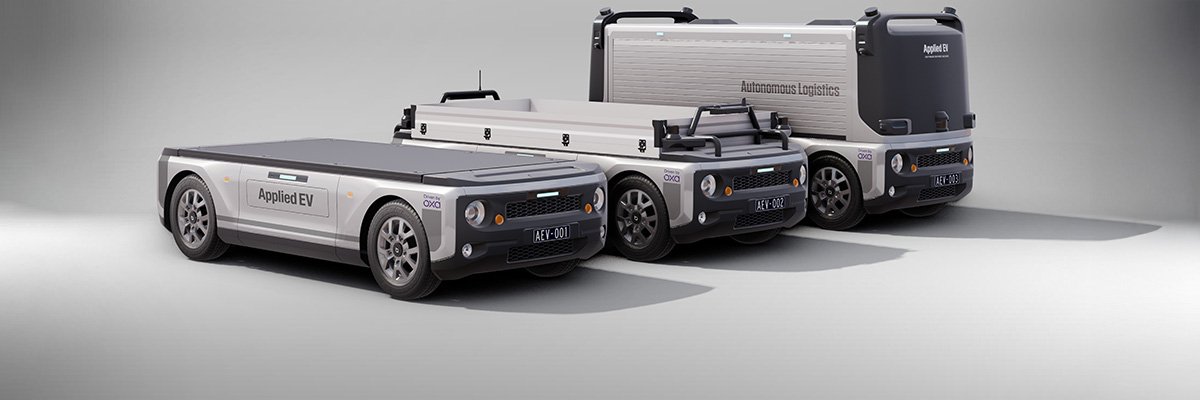Tech
Oxa gains more mileage from Nvidia for autonomous vehicles | Computer Weekly

Having started 2025 with a series of moves to boost its presence in the US, strengthen its position in industrial logistics, and extend its use and expertise in artificial intelligence (AI), UK-based autonomous vehicle (AV) technology company Oxa has extended its business relationship with AI leader Nvidia, with expanded use of the Nvidia Cosmos World Foundation Models and next-generation Nvidia Drive AGX Thor developer kits to accelerate the evolution of its self-driving software.
Explaining the rationale for its move, Oxa said the extension was part of its plan to build the future of Industrial Mobility Automation (IMA), where self-driving technology tackles the most pressing challenges facing logistics and manufacturing. Oxa believes IMA represents a $2tn market opportunity as businesses increasingly turn to automation to perform repetitive daily mobility tasks, such as passenger transportation, asset monitoring and factory parts line logistics, supporting productivity, reduced costs and innovation.
Oxa believes its work on industrial autonomy aligns with the priorities of the UK’s Advanced Manufacturing Sector Plan by advancing connected and autonomous mobility, driving research and development and strengthening the country’s position as a global hub for advanced technology.
In March 2025, Oxa announced a collaboration with Nvidia to use the latter’s Cosmos World Foundation Models – which generate photoreal virtual world states as videos from multimodal inputs such as text and images – including Cosmos Predicts Models, to enhance its own training tools, such as Oxa Sensor Expansion, which sit in its development toolchain, and Oxa Foundry.
By integrating Nvidia Cosmos World Foundation Models into its Oxa Foundry development framework, Oxa says it can use Cosmos to more quickly generate and test driving scenarios – cutting both time and cost compared with real-world testing alone.
To train and validate its software for demanding industrial environments, Oxa is also using Nvidia Cosmos World Foundation Models and the Nvidia Drive AGX Orin developer kits, which are specifically designed with the automotive input/output required for development workloads.
It is also already working to integrate the next-generation Drive AGX Thor developer kits, preparing for the future of physical AI that Oxa sees as supporting the next wave of advanced automotive workloads.
In addition, the move sees Oxa look further to the US for essential technology to fulfil its ambitions. In 2024, Oxa became the first UK AV company to export its self-driving software to the US, and its software is now present in a number of commercial deployments in both Florida and California. These initiatives are part of what Oxa calls a tangible “transatlantic loop”, where UK innovation is validated and commercialised in the US.
By deploying Nvidia’s AI software, Oxa says it is not only driving its own research and development, but is also providing a real-world blueprint, critical for attracting investment and talent to the UK, highlighting business-led innovation that creates high-value jobs and advances technology on both sides of the Atlantic.
“Our collaboration with Nvidia is a prime example of how companies from both countries can work together effectively on advanced technology development while supporting economic growth in both nations,” said Oxa CEO Gavin Jackson.
“By harnessing Nvidia’s latest technology, we are accelerating our ability to deliver safe, reliable and efficient autonomous solutions to customers today, addressing critical challenges such as driver shortages and productivity gaps,” he said.
Tech
Mold Is the Enemy. A Good Dehumidifier Is the Solution

The first thing to think about is how you’re going to drain the water from the dehumidifier. In the basement, the best thing you can do is to use the dehumidifier’s continuous water drain tube to either the sump pump or a drain. If those options are not available, you might be emptying the tank multiple times a day. The first time I put a dehumidifier in the basement, the tank was filled in three hours’ time. It’s all about the drainage. Also, knowing how to read a label. If you have a 50-pint humdidifier that means the appliance can remove 50 pints of moisture from the air in a 24-hour period; it’s not the internal tank capacity. Also, look for the maximum area coverage. For example, the Honeywell Smart 50 pint can remove 50 pints of water from 4,000 sq ft—the size of a whole house—in 24 hours.
If you, like me, also need a dehumidifier in your city apartment, then consider buying one that’s easy to move around with wheels and a handle. Some of these machines are heavy. Also, a small dehumidifier in the bathroom is a good idea to keep the dampness at bay, especially if you have mold growing on your grout.
Lastly, do not drink the water collected in your dehumidifier tank. That water is not potable. Pour it down the drain. A dehumidifier is not creating distilled water; that’s a different process and appliance.
Tech
The Justice Department Released More Epstein Files—but Not the Ones Survivors Want

Over the weekend, the Justice Department released three new data sets comprising files related to Jeffrey Epstein. The DOJ had previously released nearly 4,000 documents prior to the Friday midnight deadline required by the Epstein Files Transparency Act.
As with Friday’s release, the new tranche appears to contain hundreds of photographs, along with various court records pertaining to Epstein and his associates. The first of the additional datasets, Data Set 5, is photos of hard drives and physical folders, as well as chain-of-custody forms. Data Set 6 appears to mostly be grand jury materials from cases out of the Southern District of New York against Epstein and his coconspirator, Ghislaine Maxwell. Data Set 7 includes more grand jury materials from those cases, as well as materials from a separate 2007 Florida grand jury.
Data Set 7 also includes an out-of-order transcript between R. Alexander Acosta and the DOJ’s Office of Professional Responsibility from 2019. According to the transcript, the OPR was investigating whether attorneys in the Southern District of Florida US Attorney’s Office committed professional misconduct by entering into a non-prosecution agreement with Epstein, who was being investigated by state law enforcement on sexual battery charges. Acosta was the head of the office when the agreement was signed.
Leading up to the deadline to release materials, the DOJ made three separate requests to unseal grand jury materials. Those requests were granted earlier this month.
The initial release of the Epstein files was met with protest, particularly by Epstein victims and Democratic lawmakers. “The public received a fraction of the files, and what we received was riddled with abnormal and extreme redactions with no explanation,” wrote a group of 19 women who had survived abuse from Epstein and Maxwell in a statement posted on social media. Senator Chuck Schumer said Monday that he would force a vote that would allow the Senate to sue the Trump administration for a full release of the Epstein files.
Along with the release of the new batch of files over the weekend, the Justice Department also removed at least 16 files from its initial offering, including a photograph that depicted Donald Trump. The DOJ later restored that photograph, saying in a statement on X that it had initially been flagged “for potential further action to protect victims.” The post went on to say that “after the review, it was determined there is no evidence that any Epstein victims are depicted in the photograph, and it has been reposted without any alteration or redaction.”
The Justice Department acknowledged in a fact sheet on Sunday that it has “hundreds of thousands of pages of material to release,” claiming that it has more than 200 lawyers reviewing files prior to release.
Tech
OpenAI’s Child Exploitation Reports Increased Sharply This Year

OpenAI sent 80 times as many child exploitation incident reports to the National Center for Missing & Exploited Children during the first half of 2025 as it did during a similar time period in 2024, according to a recent update from the company. The NCMEC’s CyberTipline is a Congressionally authorized clearinghouse for reporting child sexual abuse material (CSAM) and other forms of child exploitation.
Companies are required by law to report apparent child exploitation to the CyberTipline. When a company sends a report, NCMEC reviews it and then forwards it to the appropriate law enforcement agency for investigation.
Statistics related to NCMEC reports can be nuanced. Increased reports can sometimes indicate changes in a platform’s automated moderation, or the criteria it uses to decide whether a report is necessary, rather than necessarily indicating an increase in nefarious activity.
Additionally, the same piece of content can be the subject of multiple reports, and a single report can be about multiple pieces of content. Some platforms, including OpenAI, disclose the number of both the reports and the total pieces of content they were about for a more complete picture.
OpenAI spokesperson Gaby Raila said in a statement that the company made investments toward the end of 2024 “to increase [its] capacity to review and action reports in order to keep pace with current and future user growth.” Raila also said that the time frame corresponds to “the introduction of more product surfaces that allowed image uploads and the growing popularity of our products, which contributed to the increase in reports.” In August, Nick Turley, vice president and head of ChatGPT, announced that the app had four times the amount of weekly active users than it did the year before.
During the first half of 2025, the number of CyberTipline reports OpenAI sent was roughly the same as the amount of content OpenAI sent the reports about—75,027 compared to 74,559. In the first half of 2024, it sent 947 CyberTipline reports about 3,252 pieces of content. Both the number of reports and pieces of content the reports saw a marked increase between the two time periods.
Content, in this context, could mean multiple things. OpenAI has said that it reports all instances of CSAM, including uploads and requests, to NCMEC. Besides its ChatGPT app, which allows users to upload files—including images—and can generate text and images in response, OpenAI also offers access to its models via API access. The most recent NCMEC count wouldn’t include any reports related to video-generation app Sora, as its September release was after the time frame covered by the update.
The spike in reports follows a similar pattern to what NCMEC has observed at the CyberTipline more broadly with the rise of generative AI. The center’s analysis of all CyberTipline data found that reports involving generative AI saw a 1,325 percent increase between 2023 and 2024. NCMEC has not yet released 2025 data, and while other large AI labs like Google publish statistics about the NCMEC reports they’ve made, they don’t specify what percentage of those reports are AI-related.
-

 Business1 week ago
Business1 week agoStudying Abroad Is Costly, But Not Impossible: Experts On Smarter Financial Planning
-

 Business1 week ago
Business1 week agoKSE-100 index gains 876 points amid cut in policy rate | The Express Tribune
-

 Fashion5 days ago
Fashion5 days agoIndonesia’s thrift surge fuels waste and textile industry woes
-

 Sports1 week ago
Sports1 week agoJets defensive lineman rips NFL officials after ejection vs Jaguars
-

 Business5 days ago
Business5 days agoBP names new boss as current CEO leaves after less than two years
-

 Tech1 week ago
Tech1 week agoFor the First Time, AI Analyzes Language as Well as a Human Expert
-

 Entertainment1 week ago
Entertainment1 week agoPrince Harry, Meghan Markle’s 2025 Christmas card: A shift in strategy
-

 Tech5 days ago
Tech5 days agoT-Mobile Business Internet and Phone Deals





